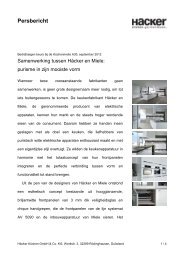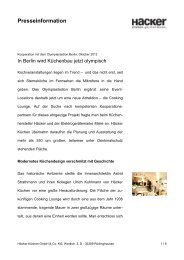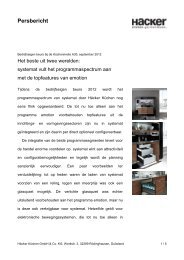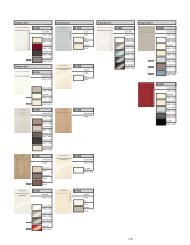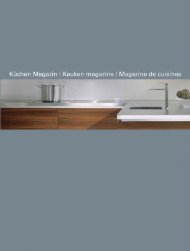Pflege- und Bedienungsanleitung
Pflege- und Bedienungsanleitung
Pflege- und Bedienungsanleitung
You also want an ePaper? Increase the reach of your titles
YUMPU automatically turns print PDFs into web optimized ePapers that Google loves.
GB E<br />
Installation/Safety<br />
The kitchen may only be installed by<br />
experienced specialists. Please note in this<br />
context that electrical and gas appliances, as<br />
well as water supply and wastewater<br />
connections may only be installed by<br />
specialists in accordance with the applicable<br />
safety regulations. Removing or omitting parts,<br />
or combining parts with those made by other<br />
manufacturers and general modifications<br />
(unless customary within the framework of<br />
kitchen installation) may jeopardize your<br />
safety and that of other people. Such changes<br />
are therefore prohibited.<br />
If parts are to be combined with parts made by<br />
other manufacturers, this must be investigated<br />
in consultation with the kitchen manufacturer<br />
before they are installed. The conditions of the<br />
room should be suitable for installation of a<br />
kitchen, i.e. the nature of the walls and their<br />
suitability for mounting tall or wall units and<br />
for attachment of retaining bars and brackets<br />
must be checked. The enclosed mounting<br />
hardware must similarly be checked to ensure<br />
that it is suitable for use on the walls in the<br />
room. Lightweight walls and cavity walls<br />
require special mounting hardware which is<br />
available from specialist retail outlets.<br />
64<br />
Tall units must be secured to the wall to<br />
prevent them tipping over, even if connected to<br />
wall units. At least every second unit in a row<br />
of tall units must be secured. Individual units,<br />
base units with wide pull-outs (80 - 120 cm)<br />
and short lines comprising only base units<br />
must similarly be secured to the wall. In<br />
addition to being attached to the wall, the<br />
furniture parts must also be connected to one<br />
another by screws.<br />
Kitchen furniture – especially the moving parts<br />
– is subjected to high loads in the course of<br />
time. For your own safety, check whether<br />
individual parts may have loosened and<br />
become insecure. In many cases, nothing<br />
more will be needed than to retighten a screw.<br />
Instalación y seguridad<br />
General Aspectos generales<br />
La instalación de una cocina es competencia<br />
única y exclusiva de profesionales<br />
experimentados. Tenga además en cuenta que<br />
la instalación de aparatos eléctricos o de gas,<br />
así como las entradas y salidas de agua, sólo<br />
puede llevarla a cabo el especialista pertinente<br />
en estricto cumplimiento de las normas de<br />
seguridad que sean de aplicación. La<br />
eliminación u omisión de componentes, su<br />
combinación con componentes externos, la<br />
modificación general de los componentes<br />
(siempre que no se aplique al montaje de la<br />
cocina) atentan contra la seguridad y no<br />
están permitidos.<br />
En caso de combinación con componentes<br />
externos, se debe realizar una comprobación<br />
antes del montaje previa consulta con el<br />
fabricante de la cocina. El espacio disponible<br />
debe ser apropiado para la instalación de una<br />
cocina, es decir, que es preciso comprobar si<br />
las paredes se hallan en perfecto estado y<br />
cerciorarse de que son apropiadas para el<br />
montaje de módulos bajos y enganchados o<br />
para el atornillado de regletas y escuadras de<br />
sujeción. Las paredes<br />
de construcción hueca o ligera, por ejemplo,<br />
necesitarán elementos de sujeción especiales,<br />
que podrá adquirir en su distribuidor<br />
especializado.<br />
Para evitar problemas de estabilidad, los<br />
módulos altos deben ir fijados a la pared<br />
incluso cuando vayan enganchados a los<br />
muebles bajos. Si los módulos altos están<br />
unidos entre sí, habrá que asegurar por lo<br />
menos uno de cada dos. Los muebles<br />
independientes, los módulos bajos de<br />
gran anchura (80-120 cm) o las cocinas<br />
pequeñas compuestas únicamente por módulos<br />
bajos deberán fijarse igualmente a la pared.<br />
Además de sujetos a la pared, los componentes<br />
deben ir atornillados entre sí.<br />
Los muebles de cocina, espicialmente los<br />
componentes móviles, acaban resintiéndose<br />
con el paso del tiempo por la carga que<br />
soportan. Por su propia seguridad, es importante<br />
comprobar si algún componente se ha<br />
aflojado y ha perdido estabilidad. En la mayoría<br />
de los casos es suficiente con apretar<br />
ligeramente algún tornillo.



